Computer designed 3D virtual models of historic illustrations and objects are always interesting and useful. Through them we can get a better idea of what something “really” looked like, when only poor illustrations, photographs, or partial and damaged originals exist. In some cases there are only descriptions left of an item, and a computer model is able to virtually recreate something that was entirely lost, or never existed at all.
In the case of the Voynich drawings, which often have poor perspective, and skewed relative dimensions, they provide an opportunity to see what may have been in the artist’s mind. I certainly don’t claim to know exactly what was in their mind, but by modeling these items, it has given a new perspective (pun intended) to what the intent may have been.
Some time ago I had modeled the Voynich Manuscript Rosettes fold out illustrations in 3D. This has always been a popular model, and the video which I made from it has at this writing over 45,000 hits. It was also recently used in a Travel Channel documentary on the Voynich (which I also appear in), for their series World’s Most Unexplained.
Below is my 2009 model of the Voynich Rosettes pages, animated with a “flyby”.
Since first modeling the Rosettes map, I’ve modified the tubes around the center “rose” to an upright position. I did this, because on second thought it seemed that this was probably the original intent of the artist. I think the only reason these vertical tubes were drawn “leaning out” is because if shown from the top view they would simply look like little circles. So the artist tipped them to illustrate the nature of these tubes from the overhead view. Perhaps I’m wrong on that, and honestly I have no idea which was intended.
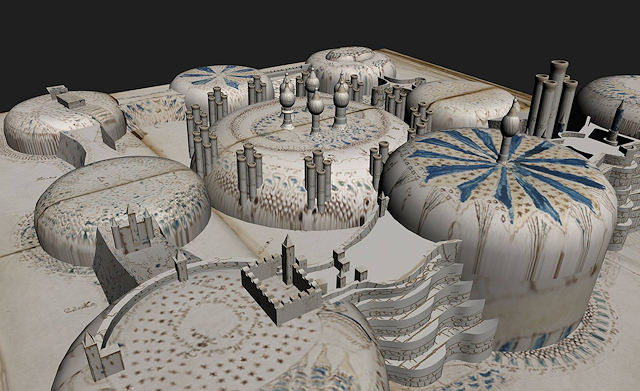
I’ve also modeled a few other items from the Voynich over the years. Below is the f88v “cylinder”, which was I think the first item I created, probably before 2010.
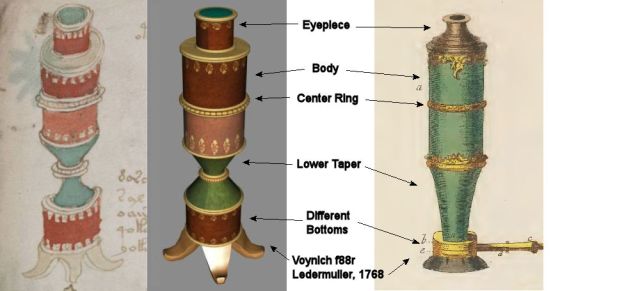
I think it is important that I point out that in modeling this, I’ve made only minimal “concessions” to actual 17th and 18th century microscope practices and materials: For one, the decorative motif is from an actual microscope, and is the gold leaf applied to a Moroccan leather covering. The other is that I gave the legs specular highlights and color similar to polished brass. And really, I don’t think those details would remove much of the f88r cylinder’s stunning similarity to a microscope. It is a fantasy instrument, I believe, but inspired by, and borrowing from, various devices. I’ve also recently noted it shares many features with the 1768 Ledermuller engraving of a microscope, as seen above.

In the above are two Voynich cylinders on the left, and the two 18th century Spanish opera glasses on the far right. I’ve used this comparison many times. But I have not posted the 3D CAD representations of the Voynich cylinders outside of Facebook, until now. Again, the only concessions I’ve made to “microscope-like” features are the glossy brass finish and the Moroccan leather covering, with decorative gilt tooling. For some reason (I note now) I didn’t model the rings at the top… so that goes on the “to do” list. But I feel, once again, that when we see these illustrations modeled in 3D, the intent seems very “optical”.
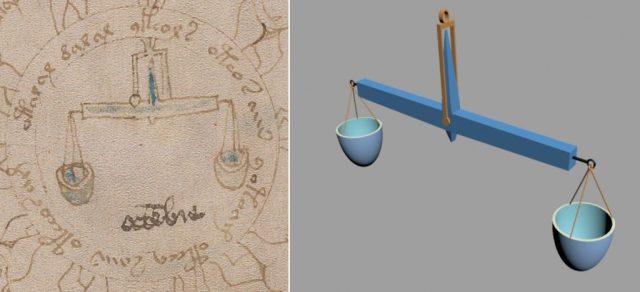
To model the f72v Libra Scales, some alteration was necessary. As shown, it would have been as impossible to model as an Escher print. For instance, the frame that the lever hangs from is askew in the illustration. It is not properly lined up with the fulcrum of the lever. I assumed that the “disk” seen on the lever was intended as the pivot, and placed it where it would be, in a real scale. And the frame opening seems to be much wider on the Voynich drawing: but that is, I think, in an attempt to avoid crowding the indicator/pointer. The hanger’s sides would normally be just outside of the lever, giving just enough clearance for the lever to freely swing. This gives the impression that the frame on my modeled version is much narrower, but I think it makes sense this way.
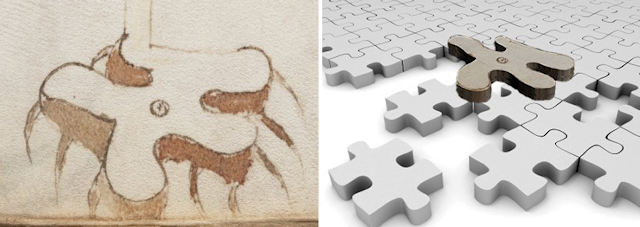 The crop on the above left is the f27v plant root. There have been many attempts at identifying this as an actual plant root, but in my opinion none of them come close to any real root. It me it looks all the world like a puzzle piece. So I modeled it in 3D, and hovered it over a graphic of other modeled pieces. Pieces of this style were only invented in the mid to late 19th century, and from the start they became an iconic representation of mysteries. I have mused on the possibility Wilfrid used this as a sort of “Catch me if you can”, a way for him to “thumb his nose” at the literary establishment.
The crop on the above left is the f27v plant root. There have been many attempts at identifying this as an actual plant root, but in my opinion none of them come close to any real root. It me it looks all the world like a puzzle piece. So I modeled it in 3D, and hovered it over a graphic of other modeled pieces. Pieces of this style were only invented in the mid to late 19th century, and from the start they became an iconic representation of mysteries. I have mused on the possibility Wilfrid used this as a sort of “Catch me if you can”, a way for him to “thumb his nose” at the literary establishment.

Above is my 3D opinion as to what was intended by our Voynich artist. Of course it is open to interpretation, but I think that the “cap” on the orb was like a little “roof”, with an “eave”. It could be sloppiness, but I do think the cap slop is slightly arced inward. In any case, if correct, what would it mean? Orbs are usually a representation of the Earth, the World, and when there is a cross on the top, it is a symbol of Christian authority. That version is the “Globus Cruciger“.
With this roof, or spire, instead of a cross, I think of this as a “secular orb”. But the actual meaning is, I think, anyone’s guess. But as a matter of interest, I believe it is on a page with Rosicrucian symbolism, and even a possible representation of Martin Luther.
Back in 2012, my friend Robert Teague asked me to model f67v for him, to help visualize certain relationships between the items on that page in a celestial sense. It was difficult for him to relay the complex elements of his ideas for f67v, and it was a work in progress for some time. I’m sorry that I am unable to explain the concept he wanted illustrated. But I copy a rendering here, to show how one can illustrate complex concepts, by modeling the (reasoned) relative positions of portions of an illustration.
I enjoyed and appreciated Robert’s work a great deal, although I admit I didn’t always understand it. When I did, I often felt he was “on to something”. He and I… as is often the case in Voynich studies… had very different theories as to what the Voynich was. But also, as in many cases, I think he was correct in believing the intent of many of the celestial items and patterns were just what he thought they were.
Robert unfortunately passed away some years ago now, and that is a loss to the Voynich community. I think it is from just such a dedicated and patient person, with an open mind, that will eventually come the answers everyone desires. 
On the overall modeling of the Rosettes maps, I made a very simple representation of the two structures on the lower right “rose”. Writing this post was an incentive to finally modeling them in greater detail.
These structures seem to be some sort of awnings or roofs on columns. They appear to have draperies hanging from the edges of the roofs. It has been suggested by Dana Scott that these might be Jewish Tabernacles. I think that is an excellent suggestion. Below is a CAD model by Aleksig6, found on the above linked Wikipedia page. The tent itself is called a “mishka”.
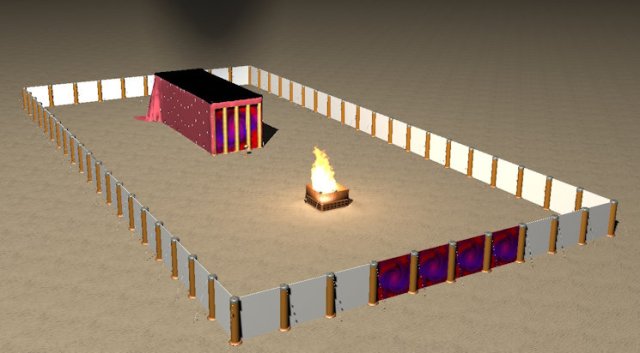
I would also like to add the beautiful, imaginative, and well-crafted glass sculptures by Cary Rapaport. They are built for their esthetic beauty foremost, but they would also serve very well to get an understanding of what the more organic plants and people of the Voynich might look like in 3D. I would love to have one of these.
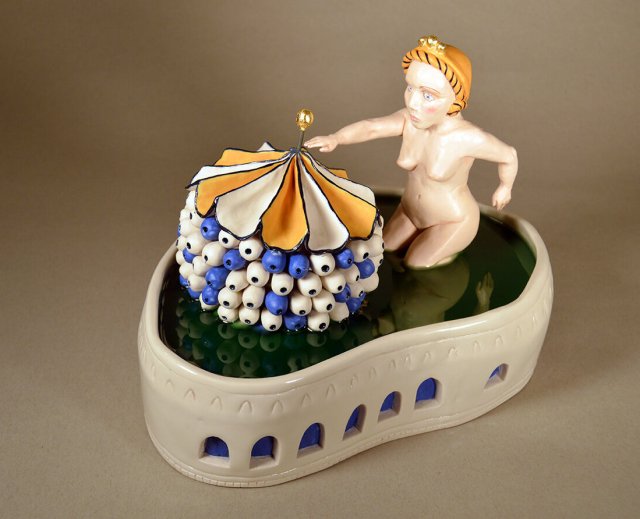
Another wonderful work by Cary Rapaport:  Hopefully these 3D representations from the Voynich are of interest, and maybe even useful to some one. Many historic questions and mysteries have been solved by looking at problems in new and unique ways. Considering the long standing impermeable nature of the Voynich mystery, it practically demands it.
Hopefully these 3D representations from the Voynich are of interest, and maybe even useful to some one. Many historic questions and mysteries have been solved by looking at problems in new and unique ways. Considering the long standing impermeable nature of the Voynich mystery, it practically demands it.

Hi Rich,
I really enjoy your 3D renditions. I knew your rosettes page from Youtube, but not the other ones. Thanks for making them all available in one place!
It was especially nice to see the tabernacle model, I too see the design in this “rose” exactly like that, so it was awesome to see it in 3D.
Well done!
Thanks much for the nice comments! I’m glad you like them…
Rich.
Pingback: Graffiti-Verschlüsselung gelöst: Hat sich der Urheber selbst verraten? – Cipherbrain
Pingback: Voynich Clysters? |
Rich, hi.
You have great 3-dimensional models.
In my opinion, the outlet model should be clarified.
Folio F86V represents the layout of the Tycho Brahe Observatory.
I would like to see an updated model, if that is possible.
Thanks in advance.
Mark
Hi Mark: I’ve seen your suggestions, and like them a great deal. I don’t know if the Observatory was meant here, or not, or if it were an influence in some way… but I don’t discount it, either. I probably won’t be updating the model to match the Observatory though, as my intent was only to show what I thought the artist intended by this illustration… I mean, what we can actually see here, on these pages.
So even if it, or parts of it, are similar to the Tycho’s Observatory, or any other thing for that matter, I wouldn’t change my CAD illustration of it to match that thing.
And even though I like your comparisons, and accept they might be involved here, I also like the idea that it was meant to look like one of the fictional Utopias: https://proto57.wordpress.com/2009/06/15/theres-no-place-like-utopia/ Nonetheless, I also wouldn’t change my model to match those Utopias (although come to think of it, it would be fun to model them, also!).
Thanks for the input, and the nice comments.
Rich.
Hi, Rich.
Very grateful for your quick and detailed answer to my question.
Indeed, you should not break the beautifully made three-dimensional model.
But I would like to see from you the reconstructed fortress of Tycho Brahe from a stylized three-dimensional image of the rosettes.
In doing so, I would like to point out that the Folio F86V depicts not twelve chimneys, but sixteen chimneys.
https://scontent.fhel5-1.fna.fbcdn.net/v/t1.6435-0/p526x296/165447436_887594148857254_8191508471928491479_n.jpg?_nc_cat=106&ccb=1-3&_nc_sid=825194&_nc_ohc=KUAr5VjKNF0AX-3JWXk&_nc_ht=scontent.fhel5-1.fna&tp=6&oh=9552520e9fd002c7360ba47add049572&oe=60A11C1A
The four chimneys, as described by Tycho Brahe in his book, were alchemical.
Products of combustion were constantly being emitted from these chimneys.
The Folio F86V plan shows them as cones and rosettes.
https://www.facebook.com/groups/628027000717428/permalink/1623492777837507/
Very grateful for the communication.
If you are interested in my suggestions, I have other written evidence about the location of Tycho Brahe’s facilities on Folio F86V.
Hi Mark: I don’t personally agree that those four rosettes are additional chimneys, but don’t say that your idea is wrong, either. I just interpret them differently than you. I think that the rosettes are smaller versions of various circular illustrations shown larger on other pages. That the rosettes foldouts are a larger scale, and they they are detailed in smaller scale versions. Maybe for a microcosm/macrocosm thing?
But it’s not a major theory, or a strong argument, so I don’t discount your possible either, or other possibilities other than ours.
Rich.